|
[PT]
Atenção:
as coordenadas publicadas não se referem ao local da cache. A cache
está disponível todos os dias das 9:00 às 17:00
horas.
[EN]
Please bear in mind that the given coordinates are not the actual
cache location. The cache is available every day only from 9:00 to
17:00.
[PT]
Que horas
são?
Actualmente, podemos
facilmente saber as horas olhando para o relógio, mas nem sempre
foi assim.
Os primeiros aparelhos que
mediam o tempo baseavam-se na sombra projectada por objectos ao
sol, ou na velocidade com que um líquido escorria de um recipiente.
Estes métodos eram populares na Pré-história. Os primeiros sistemas
de divisão dos dias e noites em “horas” passavam pela divisão do
dia solar em 12 partes iguais, independentemente da época do ano. O
uso de verdadeiras horas (períodos de tempo de igual duração) só
apareceu no séc. XV e XVI com o desenvolvimento de relógios
mecânicos.
O relógio de pêndulo foi
inventado no séc. XVII, e no séc. XVIII os relógios eram já
suficientemente precisos para poderem ser usados no mar, para
ajudar a determinar a longitude e para medições do tempo com algum
rigor científico. No entanto, sabia-se que a hora exacta estava
relacionada com a taxa de rotação da Terra, e por isso, os relógios
eram acertados periodicamente através de observações
astronómicas.
O desenvolvimento do
relógio de pêndulo atingiu o clímax no início deste século, com os
relógios de pêndulo livre, que tinham uma grande precisão. O erro
destes aparelhos era de 1 segundo/ano. Foram estes relógios que
permitiram identificar irregularidades no período de rotação da
Terra. Assim, apareceram os relógios de cristal de quartzo, e mais
tarde os relógios atómicos, que usam uma transição atómica de
frequência perfeitamente conhecida. Estes, foram posteriormente
melhorados e, actualmente existem relógios atómicos que acumulam um
erro de 1 segundo em milhares de anos.
Sabes o que é um
Segundo?
Certamente concordamos que
um segundo é a duração de 9.192.631.770 períodos da radiação
correspondente à transição entre dois níveis hiperfinos do estado
fundamental do átomo de césio 133. :)
[EN]
What time is it?
Nowadays
we can easily find out the time by looking at a watch or clock, but
it has not always been so easy.
The earliest time
measuring devices used either the shadow cast by the Sun or the
rate which water runs out of a vessel. Both methods were in use
before the earliest historical records. Early systems for dividing
the day and night into 'hours' used a simple division into twelve
parts regardless of season. The familiar use of hours, each of
identical length, only came into use in the 15th and 16th centuries
with the spread of mechanical clocks.
In the seventeenth
century the pendulum clock was developed and by the 18th century
clocks were sufficiently accurate for them to be employed at sea
for determining longitude and for scientific time measurement. The
fundamental accurate timekeeper, however, was the rotation rate of
the Earth and clocks were kept on time by means of astronomical
observations.
The development of the
pendulum clock reached its climax early this century with the Free
Pendulum clocks which had an accuracy of about a second a year.
Their use indicated the non-uniformity of the Earth's rotation.
They were succeeded by quartz crystal controlled clocks and
subsequently by clocks using an atomic transition of very
accurately known frequency. The second was redefined using this
frequency and clocks can now be made which are accurate to one
second in thousands of years.
Can you tell what a
second is?
I’m sure that you we
all agree that a second is the time that elapses during
9.192.631.770 cycles of the radiation produced by the transition
between two levels of the cesium 133 atom.
[PT]
A Cache
Para obter as coordenadas
da cache (também em Lisboa) vais ter que decifrar o mistério dos
relógios.
Não te
atrases!
[EN]
The Cache
In
order to get the cache coordinates (also in Lisbon) you'll have to
decipher the mystery of the clocks.Don’t be
late!
O mistério dos relógios /
The mystery of the
clocks
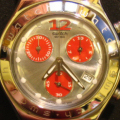
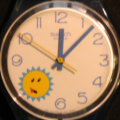
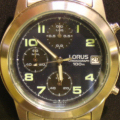



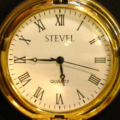
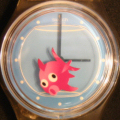
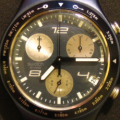



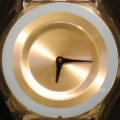

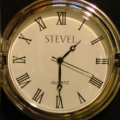








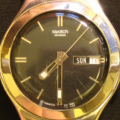







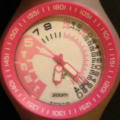


[PT]
Já descobriste
as coordenadas? Parabéns! Metade do caminho já foi percorrido. Será
que ainda estás a tempo? Que horas são agora? Tic, tac… tic, tac…
tic,tac…
|
A hora
legal em Portugal
Há um século atrás, a
“hora exacta” não existia. Cada localidade utilizava o seu próprio
tempo solar, que variava 1 min. por cada 18 km (de Este para
Oeste), e ninguém se importava! Isto só passou a ser um problema
quando se inventaram os comboios a vapor, que transportavam
rapidamente pessoas e bens entre localidades, que tinham que marcar
horas de partida, chegada, e de paragem em diferentes
localidades!
Só em 1882 se definiu a
hora universal, numa convenção em Washington, em que se dividiu o
planeta em 24 fusos horários, cada um deles correspondendo a 1
hora, começando pelo Meridiano de Greenwich. A hora neste local é
denominada hora UTC (Coordinated Universal Time).
Portugal aderiu a esta
convenção a 1 de Janeiro de 1912, data em que passámos a ter a
mesma hora do Meridiano de Greenwich.
Desde então, até hoje,
fizeram-se vários acertos: houve anos em que a hora se manteve
inalterada de Janeiro a Dezembro, anos em que se mudou a hora no
Verão e no Inverno, e anos em que a hora foi alterada mais de duas
vezes!
Desde 1986, Portugal usa o
esquema de alteração da hora decidido pela EU; em Portugal: hora de
Inverno = UTC; hora de Verão = UTC+1. Em 2006 haverá reuniões com
todos os países membros para decidirem se querem continuar com a
“hora de Verão” e de “Inverno” que ficou acordada vigorar até
2007.
|
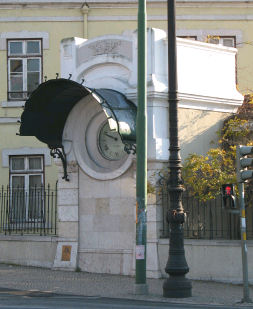
Relógio da Hora Legal do Cais do Sodré
“Legal Time Clock” in Cais
do Sodré |
|
O relógio
da Hora Legal do Cais do Sodré
Antes de Portugal adoptar
a hora legal (em 1912) a hora que usávamos era a correspondente ao
meridiano que passava pelo Observatório Astronómico de Lisboa (UTC
- 36’44,68’’). Quando os Serviços da Hora Legal foram instituídos,
Portugal passou a reger-se pela hora UTC, e foi criado o relógio da
Hora Legal do Cais do Sodré que era acertado diariamente a partir
da informação dada pelo Observatório Astronómico de Lisboa. A hora
UTC era determinada pelos astrónomos do Observatório, com base na
observação rigorosa da posição das estrelas.
O relógio foi instalado no
Cais do Sodré no princípio do século para marcar a hora exacta, que
podia ser rapidamente consultada pelos pilotos das embarcações
antes de embarcarem. Sempre que chegavam ao Porto de Lisboa, os
marinheiros aproveitavam para acertar os seus cronómetros
marítimos, fundamentais para a determinação da longitude no
mar.
|
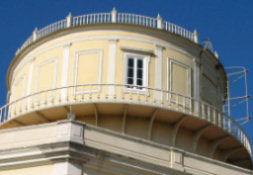
OAL Cúpula -
Dome |
|
O
Observatório Astronómico de Lisboa http://www.oal.ul.pt/
A construção do O.A.L.
teve início em 1861, na sequência de uma engraçada e acesa polémica
internacional relacionada com a determinação da paralaxe de algumas
estrelas. O edifício foi desenhado com base na arquitectura do
Observatório Russo de Poulkova.
Uma das responsabilidades
do Observatório tem sido a manutenção da Hora Legal em Portugal. Em
meados do século passado esta tarefa era exclusivamente feita por
astrónomos, pois a observação rigorosa das estrelas permitia
acertar os relógios de então com uma precisão muito superior à que
estes possuíam. Com o advento da electrónica e de outros padrões
internacionais de medição do tempo, o OAL equipou-se com relógios
atómicos para desempenhar esta função.
É na sala de observação
Oeste do OAL que se encontra a luneta meridiana que foi usada para
a determinação do tempo e de coordenadas de estrelas, com grande
precisão. Esta sala está forrada a madeira, e o tecto abre,
proporcionando uma visão do céu, segundo todo o meridiano de
Lisboa, desde Norte a Sul.
Os relógios de quartzo e
atómicos estão numa outra sala e ainda hoje são os responsáveis
pela manutenção da Hora Legal em Portugal, com uma precisão da
ordem do microssegundo. Se quiseres andar sempre a horas CERTAS é
só visitar este link do OAL: http://www.oal.ul.pt/index.php?link=acerto
|
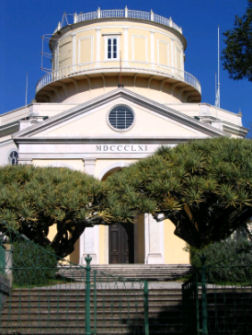
OAL Entrada -
Entrance |
[EN]
Have you
already found the coordinates? Congratulations!
You’re now
half way from the cache. Are you still on time?
What time is
it now?Tic, tac.. tic, tac… tic, tac…
|
Legal time
in Portugal
Last century, there was
no such thing as the exact time. Each place had its own solar time,
that varied 1 min. for each 18 km (East to West), and everyone was
ok about it. This only became a problem when the steaming train was
invented: people and goods began travelling fast from town to town,
and the train stations had to set up departure and arrival times.
Plus, all the trains should know the exact time so that they
wouldn’t use the same line, in opposite directions at the same
moment!
The Universal Time was
only defined in 1882, in an international meeting in Washington, in
which the planet was divided in 24 time zones, each one with one
hour plus than the one before, beginning in the Greenwich Meridian.
The time in Greenwich meridian is called UTC (Coordinated Universal
Time).
Portugalhas adopted this way of measuring time in
1st January 1912, when we began using the exact same
hour as Greenwich.
Since then, time in
Portugal has changed quite a lot: there were years with Winter and
Summer time, years with the same time throughout, and even years in
which time has changed twice!
Since 1986, Portugal
has been using the EU way of changing time; in Portugal: Winter
time = UTC; Summer time = UTC + 1. In 2006 there will be a series
of EU meetings in which all the country members will decide on
whether to go on with this scheme of Winter and Summer time, or
change it to a different one. The actual scheme will last until
2007, as early decided.
|

OAL Tecto -
Ceiling

OAL Museu / Instrumentos -
Museum / Instruments |
|
“Legal
Time Clock” in Cais do Sodré
Before Portugal’s
decision to adopt the Legal Time (in 1912), the hour in our country
was dictated by the meridian that passes through Lisbon Astronomic
Observatory (OAL): UTC – 36’44,68’’.
In 1912 the Legal Hour
Services were created, and Portugal began using the UTC time. Every
day, the “Legal Time Clock” in Cais do Sodré was set according to
OAL readings. UTC time was accurately determined by the
astronomers, based on precise measures of the stars
positions.
The clock was built in
Cais do Sodré in the beginning of the century, with the purpose of
showing the exact time, so that ship pilots could set their own
maritime chronometers accurately before going on a journey. The
maritime chronometers are fundamental in the sea to determine the
exact position of the ship (mainly longitude).
|
OAL Lunette
méridienne |
|
LisbonAstronomic Observatory http://www.oal.ul.pt/
Buildingof Lisbon Astronomic
Observatory(OAL)
began in 1861, after a strong and quite funny international
discussion about the determination of the parallax of some stars.
The building was designed after the architecture of the Russian
Observatory in Poulkova.
One of the main
responsibilities of the OAL has been the determination and
maintenance of the Legal Time in Portugal. In the 19th
Century this was accomplished by the astronomers working in the
OAL, since the observation of the stars allowed them to know the
exact Legal Time, and hence set the clocks accurately with a
precision much higher than the one they possessed then. Progresses
in electronics and new international ways of measuring time have
led the OAL to buy whole new modern atomic watches that now tell
the Legal Time any time.
In the West Observation
Room of the OAL there is a lunette méridienne* that
was used to determine the exact time based on the position of the
stars. This room is very beautiful, totally covered in wood on the
inside, and the ceiling opens up, allowing people to see the whole
sky, from North to South, throughout the meridian that passes
through Lisbon.
The quartz and atomic
watches are in a different room, and they are still the ones
telling us the exact Legal Time, with an error smaller than 1
microsec.
If you want to be
always ON TIME just visit the following link of OAL:
http://www.oal.ul.pt/index.php?link=acerto |
*
A lunette méridienne is
an optical instrument for precisely determining the moments in time
when stars and planets in the sky cross a defined astronomical
meridian (as in the Greenwich Meridian). Before the establishment
of more accurate electronic and atomic time scales in the 20th
century, instruments of this sort were used to calibrate
clocks. |
Informações
Úteis / Useful information
O
OAL está inserido na Tapada da Ajuda. É possível visitar a tapada
todos os dias das 9:00 às
17:00.
A
entrada é gratuita, mas se desejar levar carro paga
1€.
Para chegar ao OAL utilizando transportes públicos,
aconselho o autocarro nº24, nº60 e o eléctrico
nº18.
A
entrada faz-se pela Calçada da Tapada N 38
42.365 W 009
10.956.
The OAL is located in the Tapada da Ajuda. You can
visit the Tapada every day from 9 a.m. to 5
p.m.
Entrance is free but you will have to pay 1 euro if
you take the car.
Recommended public transports are: bus 24 or 60.
Electric cable bus 18.
The access to the Tapada is via street Calçada da
Tapada
N 38 42.365 W 009
10.956
.
Mapa da Tapada
da Ajuda / Map
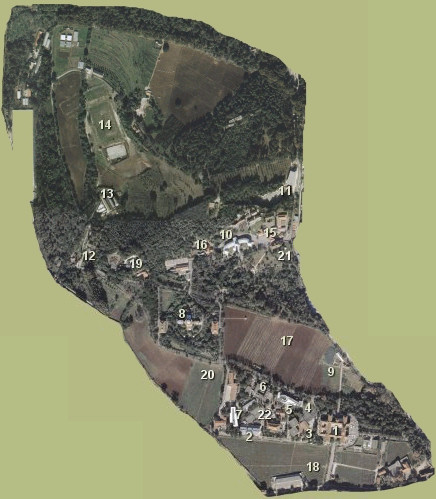
|
1 Edifício
principal do Instituto Superior de Agronomia/
Main
building of the Agronomical University
2 Bloco de
aulas / Classes
3 Cantina /
Canteen
4
Polidesportivos / Sports Area
5 Biblioteca
/ Library
6 Eng.
Florestal / Forest Eng.
7 Pavilhão
Agro-industriais e Tropicais /
Agro-Industrial and Tropical pavilion
8
OAL
9 Estação
Meteorológica / Weather Station
10
Pavilhão de
Exposições/ Exposition Pavilion
11 Auditório
da Lagoa Branca
/ “White
Lagoon” Auditorium
12
Viveiros/ Plants Facility
13 Geradora
/ Power supply
14
Rugby
15 Secção de
produção animal
/ Animal
Production
16
Secção de
Arquitectura
Paisagista/ Landscape Architecture Facility
17 Terra
Grande /
18 Vinha /
Vine
19 Centro de
Ecologia Aplicada / Center of Applied Ecology
20 Pomar /
Orchard
21 Chalé /
Main House
22 Herbário /
Herbarium |
Pontos de interesse / Points of interest

1 Edifício
principal do Instituto Superior de Agronomia/
Main
building of the Agronomical University
N 38 42,456 W
009 10,906 |
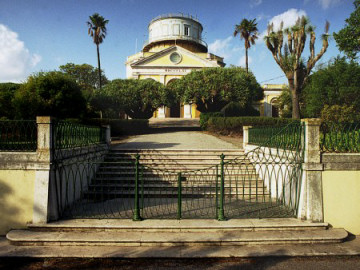
8
OAL
N 38 42,618 W 009 11,247 |
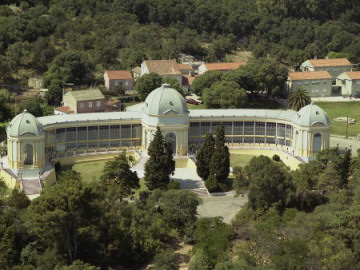
10
Pavilhão de
Exposições/ Exposition pavilion
N 38 42,745 W
009 11,144 |

;)
N 38 42,537 W
009 11,077
|
Por favor não publique nenhuma informação ou foto
que possa evidenciar a localização da Cache!
Please, do not publish any info or photos that can disclose the
cache spot!
|